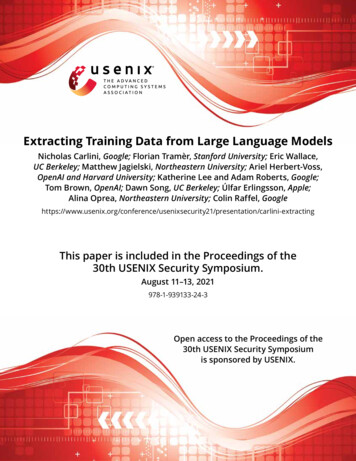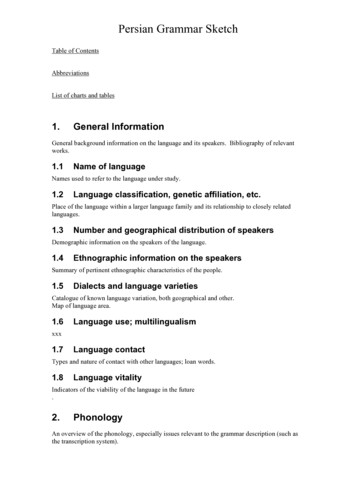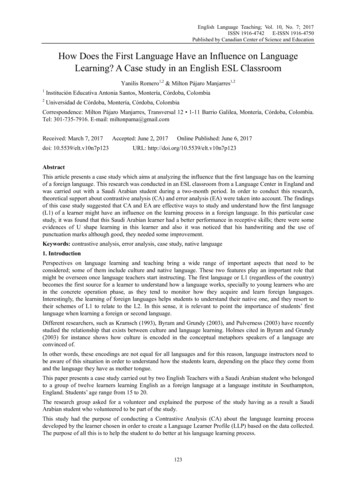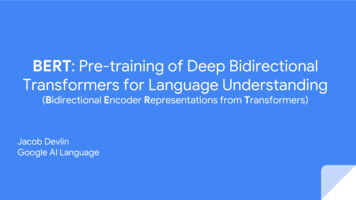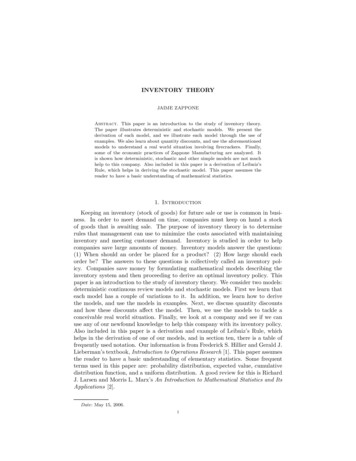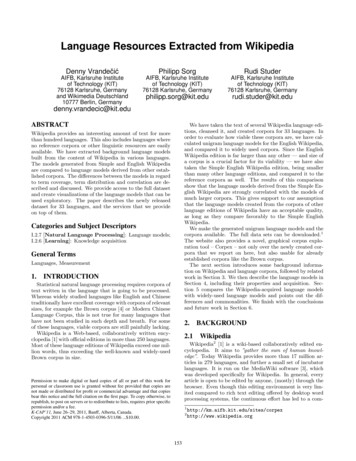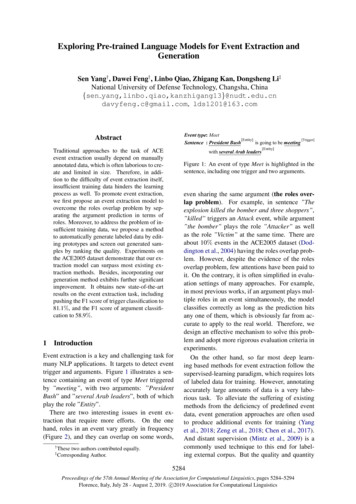
Transcription
Exploring Pre-trained Language Models for Event Extraction andGenerationSen Yang† , Dawei Feng† , Linbo Qiao, Zhigang Kan, Dongsheng Li‡National University of Defense Technology, Changsha, China{sen c@gmail.com, lds1201@163.comEvent type: Meet[Entity][Trigger]Sentence : President Bushis going to be meetingAbstractTraditional approaches to the task of ACEevent extraction usually depend on manuallyannotated data, which is often laborious to create and limited in size. Therefore, in addition to the difficulty of event extraction itself,insufficient training data hinders the learningprocess as well. To promote event extraction,we first propose an event extraction model toovercome the roles overlap problem by separating the argument prediction in terms ofroles. Moreover, to address the problem of insufficient training data, we propose a methodto automatically generate labeled data by editing prototypes and screen out generated samples by ranking the quality. Experiments onthe ACE2005 dataset demonstrate that our extraction model can surpass most existing extraction methods. Besides, incorporating ourgeneration method exhibits further significantimprovement. It obtains new state-of-the-artresults on the event extraction task, includingpushing the F1 score of trigger classification to81.1%, and the F1 score of argument classification to 58.9%.1with several Arab leadersFigure 1: An event of type Meet is highlighted in thesentence, including one trigger and two arguments.IntroductionEvent extraction is a key and challenging task formany NLP applications. It targets to detect eventtrigger and arguments. Figure 1 illustrates a sentence containing an event of type Meet triggeredby ”meeting”, with two arguments: ”PresidentBush” and ”several Arab leaders”, both of whichplay the role ”Entity”.There are two interesting issues in event extraction that require more efforts. On the onehand, roles in an event vary greatly in frequency(Figure 2), and they can overlap on some words,†‡These two authors contributed equally.Corresponding Author.[Entity]even sharing the same argument (the roles overlap problem). For example, in sentence ”Theexplosion killed the bomber and three shoppers”,”killed” triggers an Attack event, while argument”the bomber” plays the role ”Attacker” as wellas the role ”Victim” at the same time. There areabout 10% events in the ACE2005 dataset (Doddington et al., 2004) having the roles overlap problem. However, despite the evidence of the rolesoverlap problem, few attentions have been paid toit. On the contrary, it is often simplified in evaluation settings of many approaches. For example,in most previous works, if an argument plays multiple roles in an event simultaneously, the modelclassifies correctly as long as the prediction hitsany one of them, which is obviously far from accurate to apply to the real world. Therefore, wedesign an effective mechanism to solve this problem and adopt more rigorous evaluation criteria inexperiments.On the other hand, so far most deep learning based methods for event extraction follow thesupervised-learning paradigm, which requires lotsof labeled data for training. However, annotatingaccurately large amounts of data is a very laborious task. To alleviate the suffering of existingmethods from the deficiency of predefined eventdata, event generation approaches are often usedto produce additional events for training (Yanget al., 2018; Zeng et al., 2018; Chen et al., 2017).And distant supervision (Mintz et al., 2009) is acommonly used technique to this end for labeling external corpus. But the quality and quantity5284Proceedings of the 57th Annual Meeting of the Association for Computational Linguistics, pages 5284–5294Florence, Italy, July 28 - August 2, 2019. c 2019 Association for Computational Linguistics
trumentTimeFigure 2: Frequency of roles that appear in events oftype Injure in the ACE2005 dataset.of events generated with distant supervision arehighly dependent on the source data. In fact, external corpus can also be exploited by pre-trainedlanguage models to generate sentences. Therefore,we turn to pre-trained language models, attempting to leverage their knowledge learned from thelarge-scale corpus for event generation.Specifically, this paper proposes a frameworkbased on pre-trained language models, which includes an event extraction model as our baselineand a labeled event generation method. Our proposed event extraction model is constituted of atrigger extractor and an argument extractor whichrefers result of the former for inference. In addition, we improve the performance of the argumentextractor by re-weighting the loss function basedon the importance of roles.Pre-trained language models have also been applied to generating labeled data. Inspired by thework of Guu et al. (2018), we take the existingsamples as prototypes for event generation, whichcontains two key steps: argument replacement andadjunct token rewriting. Through scoring the quality of generated samples, we can pick out thoseof high quality. Incorporating them with existingdata can further improve the performance of ourevent extractor.2Related workEvent Extraction In terms of analysis granularity,there are document-level event extraction (Yanget al., 2018) and sentence-level event extraction(Zeng et al., 2018). We focus on the statisticalmethods of the latter in this paper. These methods can be further divided into two detailed categories: the feature based ones (Liao and Grishman, 2010; Liu et al., 2010; Miwa et al., 2009; Liuet al., 2016; Hong et al., 2011; Li et al., 2013b)which track designed features for extraction, andthe neural based ones that take advantage of neural networks to learn features automatically (Chenet al., 2015; Nguyen and Grishman, 2015; Fenget al., 2016).Event Generation External resources such asFreebase, Frame-Net and WordNet are commonlyemployed to generate event and enrich the training data. Several previous event generation approaches (Chen et al., 2017; Zeng et al., 2018)base a strong assumption in distant supervision1to label events in unsupervised corpus. But in fact,co-occurring entities could have none expected relationship. In addition, Huang et al. (2016) incorporates abstract meaning representation and distribution semantics to extract events. While Liu et al.(2016, 2017) manages to mine additional eventsfrom the frames in FrameNet.Pre-trained Language Model Pre-trained language models are capable of capturing the meaning of words dynamically in consideration of theircontext. McCann et al. (2017) exploits languagemodel pre-trained on supervised translation corpusin the target task. ELMO (Embeddings from Language Models) (Peters et al., 2018) gets contextsensitive embeddings by encoding characters withstacked bidirectional LSTM (Long Short TermMemory) and residual structure (He et al., 2016).Howard and Ruder (2018) obtains comparable result on text classification. GPT (Generative PreTraining) (Radford et al., 2018) improves the stateof the art in 9 of 12 tasks. BERT (BidirectionalEncoder Representations from Transformers) (Devlin et al., 2018) breaks records of 11 NLP taskand received a lot of attention.3Extraction ModelThis section describes our approach to extractevents that occur in plain text. We consider eventextraction as a two-stage task, which includes trigger extraction and argument extraction, and propose a Pre-trained Language Model based EventExtractor (PLMEE). Figure 3 illustrates the architecture of PLMEE. It consists of a trigger extractorand an argument extractor, both of which rely onthe feature representation of BERT.3.1Trigger ExtractorTrigger extractor targets to predict whether a tokentriggers an event. So we formulate trigger extraction as a token-level classification task with labels1If two entities have a relationship in a knowledge base,then all sentences that mention these two entities will expressthat relationship.5285
Conflict.Attack0 1ClassifierFor inferenceWordPieceSegment0 10 10 1Cstart CendCstart CendAttackerVictimPlaceEmbeddingBERT0 1Cstart eddingTheexplosionkilledthebomberandthreeshoppers0 10 1Cstart Cend.Classifier erPosition0 1WordPieceSegmentArgumentPositionThe explosion killed the bomber and three shoppersThe explosion killed the bomber and three shoppersFigure 3: Illustration of the PLMEE architecture, including a trigger extractor and an argument extractor. Theprocessing procedure of an event instance triggered by the word ”killed” is also shown.being event types, and just add a multi-classifieron BERT to build the trigger extractor.The input of the trigger extractor follows theBERT, i.e. the sum of three types of embeddings, including WordPiece embedding (Wu et al.,2016), position embedding and segment embedding. Since the input contains only one sentence,all its segment ids are set to zero. In addition, token [CLS] and [SEP]2 are placed at the start andend of the sentence.In many cases, the trigger is a phrase. Therefore, we treat consecutive tokens which share thesame predicted label as a whole trigger. As general, we adopt cross entropy as the loss functionfor fine-tuning.3.23.3Argument Span DeterminationIn PLMEE, a token t is predicted as the start of anargument that plays role r with probability:Argument ExtractorGiven the trigger, argument extractor aims to extract related arguments and all roles they play.Compared with trigger extraction, argument extraction is more complicated because of three issues: the dependency of arguments on the trigger,most arguments being long noun phrases, and theroles overlap problem. We take exactly a series ofactions to deal with these obstacles.In common with trigger extractor, argument extractor requires three kinds of embeddings as well.However, it needs to know which tokens comprisethe trigger. Therefore, we feed argument extractorwith the segment ids of trigger tokens being one.2To overcome the latter two issues in argumentextraction, we add multiple sets of binary classifiers on the BERT. Each set of classifiers sever fora role to determine the spans (each span includes astart and an end) of all arguments that play it. Thisapproach is similar to the question answering taskon the SQuAD (Rajpurkar et al., 2016) in whichthere is only one answer, while multiple argumentsplaying the same role can appear simultaneouslyin an event. Since the prediction is separated withroles, an argument can play multiple roles, and atoken can belong to different arguments. Thus, theroles overlap problem can also be solved.[CLS], [SEP] and [MASK] are special tokens of BERT.Psr (t) Sof tmax (Wsr · B (t)) ,while as the end with probability:Per (t) Sof tmax (Wer · B (t)) ,in which we use subscript ”s” to represent ”start”and subscript ”e” to represent ”end”. Wsr is theweight of binary classifier that aims to detect startsof arguments playing role r, while Wer is theweight of another binary classifier that aims to detect ends. B is the BERT embedding.For each role r, we can get two lists Bsr and Berof 0 and 1 according to Psr and Per . They indicaterespectively whether a token in the sentence is the5286
start or end of an argument that plays role r3 . Algorithm 1 is used to detect each token sequentiallyto determine spans of all arguments that play therole r.entropy between the output probabilities and thegolden label y:Ls X1CE (Psr , ysr ) , R S r RAlgorithm 1 Argument span determinationIn: Psr and Per , Bsr and Ber , sentence length l.Out: Span list L of the arguments that play role rInitiate: as -1, ae 20:21:22:for i 0 to l doif In State 1 & the ith token is a start thenas i and change to State 2end ifif In State 2 thenif the ith token is a new start thenas i if Psr [i] Psr [as ]end ifif the ith token is an end thenae i and change to State 3end ifend ifif In State 3 thenif the ith token is a new end thenae i if Per [i] Per [ae ]end ifif the ith token is a new start thenAppend [as , ae ] to Lae -1, as i and change to State 2end ifend ifend forAlgorithm 1 contains a finite state machine,which changes from one state to another in response to Bsr and Ber . There are three states totally: 1) Neither start nor end has been detected;2) Only a start has been detected; 3) A start as wellas an end have been detected. Specially, the statechanges according to the following rules: State 1changes to State 2 when the current token is a start;State 2 changes to State 3 when the current tokenis an end; State 3 changes to State 2 when the current token is a new start. Notably, if there has beena start and another start arises, we will choose theone with higher probability, and the same for end.3.4in which CE is cross entropy, R is the set of roles,S is the input sentence, and S is the number oftokens in S. Similarly, we define Le as the lossfunction of all binary classifiers that detect ends:Le r RWe finally average Ls and Le as the loss L of argument extractor.As Figure 2 shows, there exists a big gap in frequency between roles. This implies that roles havedifferent levels of ”importance” in an event. The”importance” here means the ability of a role toindicate events of a specific type. For example,the role ”Victim” is more likely to indicate a Dieevent than the role ”Time”. Inspired by this, were-weight Ls and Le according to the importanceof roles, and propose to measure the importancewith the following definitions:Role Frequency (RF) We define RF as the frequency of role r appearing in events of type v:RF(r, v) P3The ith token is a start if Bsr [i] 1 or an end if Ber [i] 1.Nvrkk R Nv,where Nvr is the count of the role r that appear inthe events of type v.Inverse Event Frequency (IEF) As the measure of the universal importance of a role, we define IEF as the logarithmically scaled inverse fraction of the event types that contain the role r:IEF(r) log V , {v V : r v} where V is tht set of event types.Finally we take RF-IEF as the product of RFand IEF: RF-IEF(r, v) RF(r, v) IEF(r). WithRF-IEF, we can measure the importance of a roler in events of type v:expRF-IEF(r,v).RF-IEF(r0 ,v)r0 R expLoss Re-weightingWe initially define Ls as the loss function of allbinary classifiers that are responsible for detecting starts of arguments. It is the average of crossX1CE (Per , yer ) . R S I(r, v) PWe choose three event types and list the twomost important roles of each type in Table 1. Itshows that although there could be multiple roles5287
Event TypeTransport(15)Attack(14)Die(12)Top 2 RolesArtifact, OriginAttacker, TargetVictim, AgentSum0.760.850.90Table 1: Top two roles and their sum importance foreach event type. The number in brackets behind eventtype is the count of roles that have appeared in it.fine-tune it on the ACE2005 dataset with themasked language model task (Devlin et al., 2018)to bias its prediction towards the dataset distribution. In common with the pre-training procedureof BERT, each time we sample a batch of sentences and mask 15% of tokens. Its goal is stillto predict the correct token without supervision.4.2in events of someone type, only a few of them isindispensable.Give the event type v of input, we re-weight Lsand Le based on each role’s importance in v:Ls X I(r, v)CE (Psr , ysr ) S r RLe X I(r, v)CE (Per , yer ) . S r RThe loss of argument extractor L is still the average of Ls and Le .4Training Data GenerationIn addition to PLMEE, we also propose a pretrained language model based method for eventgeneration as illustrated in Figure 4. By editing prototypes, this method can generate a controllable number of labeled samples as the extratraining corpus. It consists of three stages: preprocessing, event generation and scoring.To facilitate the generation method, we defineadjunct tokens as the tokens in sentences excepttriggers and arguments, including not only wordsand numbers, but also punctuation. Taking sentence in Figure 1 as an example, ”is” and ”going”are adjunct tokens. It is evident that adjunct tokenscan adjust the smooth and diversity of expression.Therefore, we try to rewrite them to expand the diversity of the generation results, while keeping thetrigger and arguments unchanged.4.1Pre-processingWith the golden labels, we first collect argumentsin the ACE2005 dataset as well as the roles theyplay. However, those arguments overlap with others are excluded. Because such arguments are often long compound phrases that contain too muchunexpected information, and incorporating themin argument replacement could bring more unnecessary errors.We also adopt BERT as the target model torewrite adjunct tokens in the following stage, andEvent generationTo generate events, we conduct two steps on a prototype. We first replace the arguments in the prototype with those similar that have played the samerole. Next, we rewrite adjunct tokens with the finetuned BERT. Through these two steps, we can obtain a new sentence with annotations.Argument Replacement The first step is to replace arguments in the event. Both the argumentto be replaced and the new one should have playedever the same role. While the roles are inheritedafter replacement, so we can still use origin labelsfor the generated samples.In order not to change the meaning drastically,we employ similarity as the criteria for selectingnew arguments. It is based on the following twoconsiderations: one is that two arguments that playthe same role may diverge significantly in semantics; another is that the role an argument playsis largely dependent on its context. Therefore,we should choose arguments that are semanticallysimilar and coherent with the context.We use cosine similarity between embeddingsto measure the similarity of two arguments. Anddue to ELMO’s ability to handle the OOV problem, we employ it to embed arguments:E(a) 1 XE(t), a t awhere a is the argument, E is ELMO embedding.We choose the top 10 percent most similar arguments as candidates, and use softmax operation ontheir similarity to allocate probability.An argument is replaced with probability 80%while keeping constant with probability 20% tobias the representation towards the actual event(Devlin et al., 2018). Note that the triggers remainunchanged to avoid undesirable deviation of dependency relation.Adjunct Token Rewriting The results of argument replacement can already be considered as thegenerated data, but the constant context may increase the risk of overfitting. Therefore, to smooth5288
DatasetBERTArgumentCollectionFine-tuningEntity1. President2. Prime minister Blair3. the prime minister4. the Arab leaders5. an Arab counterpart6. the Palestinians7. the leaders8. .In: President Bush is going to be meetingwith several Arab leadersArgumentReplacementQuality: 0.5Prime minister Blair is going to be meetingwith the leadersScorerAdjunct TokenRewritingBERTOut: Prime minister Blair is reported to themeeting with the leadersStage 1: Pre-processingStage 2: Event generationStage 3: ScoringFigure 4: Flow chart of the generation approach.the generated data and expand their diversity, wemanage to rewrite adjunct tokens with the finetuned BERT.The rewriting is to replace some adjunct tokensin the prototype with the new ones that are morematchable with the current context. We take it asa Cloze task (Taylor, 1953), where some adjuncttokens are randomly masked and the BERT finetuned in the first stage is used to predict vocabularyids of suitable tokens based on the context. We usea parameter m to denote the proportion of adjuncttokens that need to be rewritten.Adjunct token rewriting is a step-by-step process. Each time we mask 15% of adjunct tokens(with the token [MASK]). Then the sentence is fedinto BERT to produce new adjunct tokens. The adjunct tokens that have not yet been rewritten willtemporarily remain in the sentence.To further illustrate the above two steps, we givean instance in Figure 4. In this instance, we setm to 1.0, which means all the adjunct tokens willbe rewritten. The final output is ”Prime ministerBlair is reported to the meeting with the leaders”,which shares the labels with the original event inthe prototype. It is evident that some adjunct tokens are preserved despite m is 1.0.4.3ScoringTheoretically, infinite number of events can begenerated with our generation method. However,not all of them are valuable for the extractor andsome may even degrade its performance. Therefore, we add an extra stage to quantify the qualityof each generated sample to pick out those valuable. Our key insight for evaluating the qualitylies that it is tightly related to two factors, whichare the perplexity and the distance to the originaldataset. The former reflects the rationality of gen-eration, and the latter reflects the differences between the data.Perplexity (PPL) Different with the maskedperplexity (Devlin et al., 2018) of logarithmic version, we take the average probability of those adjunct tokens that have been rewritten as the perplexity of generated sentence S 0 :X1PPL(S 0 ) P (t),0 A(S ) 0t A(S )where A is the set of adjunct tokens in S 0 that havebeen rewritten.Distance (DIS) We measure the distance between S 0 and the dataset D with cosine similarity:1 X B(S 0 ) · B(S).DIS(S 0 , D) 1 D B(S 0 ) B(S) S DDifferent with embedding arguments by ELMO,we utilize BERT to embed sentence and take theembedding of the first token [CLS] as the sentenceembedding.Both the PPL and the DIS are limited in [0,1].We consider that generated samples of high quality should have both low PPL and DIS. Therefore,we define the quality function as: Q(S 0 ) 1 λPPL S 0 (1 λ) DIS S 0 , D, where λ [0, 1] is the balancing parameter. Thisfunction is used to select generated samples ofhigh quality in experiments.5ExperimentsIn this section, we first evaluate our event extractorPLMEE on the ACE2005 dataset. Then we give acase study of generated samples and conduct automatic evaluations by adding them into the training set. Finally, we illustrate the limitations of thegeneration method.5289
PhaseModelCross EventCross EntityMax MEETriggerIdentification(%)PRFN/AN/A76.9 65.0 70.480.4 67.7 73.568.5 75.7 71.979.7 69.6 74.3N/AN/ATriggerCalssfication(%)PRF68.7 68.9 68.872.9 64.3 68.373.7 62.3 67.575.6 63.6 69.166.0 73.0 69.375.7 66.0 70.579.5 60.7 68.878.0 66.3 71.784.8 83.7 84.281.0 80.4 80.7ArgumentIdentification(%)PRF50.9 49.7 50.353.4 52.9 53.169.8 47.9 56.868.8 51.9 59.161.4 64.2 62.871.4 56.9 63.3N/AN/A71.5 59.2 64.771.4 60.1 65.3ArgumentCalssfication(%)PRF45.1 44.1 44.651.6 45.5 48.364.7 44.4 52.762.2 46.9 53.554.2 56.7 55.462.8 50.1 55.7N/AN/A61.7 53.9 57.562.3 54.2 58.0Table 2: Performance of all methods. Bold denotes the best result.As previous works (Li et al., 2013b; Chen et al.,2015; Hong et al., 2011), we take the test setwith 40 newswire documents, while 30 other documents as the validation set, and the remaining529 documents to be the training set. However,different with previous works, we take the following criteria to evaluate the correctness of each predicted event mention:1. A trigger prediction is correct only if its spanand type match with the golden labels.2. An argument prediction is correct only if itsspan and all roles it plays match with thegolden labels.It is worth noting that all the predicted roles foran argument are required to match with the goldenlabels, instead of just one of them. We adopt Precision (P), Recall (R) and F measure (F1) as theevaluation metrics.5.1Results of Event ExtractionWe take several previous classic works for comparison, and divide them into three categories:Feature based methods Document-level information is utilized in Cross event (Liao and Grishman, 2010) to assist event extraction. WhileCross entity (Hong et al., 2011) uses cross-entityinference in extraction. Max Extropy (Li et al.,2013a) extracts triggers as well as arguments together based on structured prediction.Neural based methods DMCNN (Chen et al.,2015) adopts firstly dynamic multi-pooling CNNto extract sentence-level features automatically.JRNN (Nguyen et al., 2016) proposes a jointframework based on bidirectional RNN for eventextraction.External resource based methods DMCNNDS (Chen et al., 2017) uses FreeBase to labelpotential events in unsupervised corpus by distance supervision. ANN-FN (Liu et al., 2016)improves extraction with additionally events automatically detected from FrameNet, while ANNAugATT (Liu et al., 2017) exploits argument information via the supervised attention mechanisms toimprove the performance further.In order to verify the effectiveness of loss reweighting, two groups of experiments are conducted for comparison. Namely, the group wherethe loss function is simply averaged on all classifiers’ output (indicated as PLMEE(-)) and thegroup where the loss is re-weighted based on roleimportance (indicated as PLMEE).Table 2 compares the results of the aforementioned models with PLMEE on the test set. As isshown, in both the trigger extraction task and theargument extraction task, PLMEE(-) has achievedthe best results among all the compared methods. The improvement on the trigger extractionis quite significant, seeing a sharp increase of near10% on the F1 score. While the improvement inargument extraction is not so obvious, achievingabout 2%. This is probably due to the more rigorous evaluation metric we have taken and the difficulty of argument extraction task as well. Moreover, compared with feature based methods, neural based methods can achieve better performance.And the same observation appears when comparing external resource based methods with neuralbased methods. It demonstrates that external re-5290
PrototypePresident Bush isgoing to be meetingwith several Arableadersm0.20.40.60.81.0Generated EventRussian President Putin is going to the meeting with the Arab leadersThe president is reported to be meeting with an Arab counterpartMr. Bush is summoned to a meeting with some Shiite Muslim groupsThe president is attending to the meeting with the PalestiniansPrime minister Blair is reported to the meeting with the leadersTable 3: Example samples generated with different proportion of rewritten adjunct tokens. Italic indicates argumentand bold indicates trigger.sources are useful to improve event extraction. Inaddition, the PLMEE model can achieve better results on the argument extraction task - with improvement of 0.6% on F1 score for identificationand 0.5% for classification - than the PLMEE(-)model, which means that re-weighting the loss caneffectively improve the performance.5.2Case StudyTable 3 illustrates a prototype and its generationwith parameter m ranging from 0.2 to 1.0. Wecan observe that the arguments after replacementcan match the context in prototype relatively well,which indicates that they are resembling with theoriginal ones in semantic.On the other hand, rewriting the adjunct tokenscan smooth the generated data and expand their diversity. However, since there is no explicit guide,this step can also introduce unpredictable noise,making the generation not fluent as expected.5.3Automatic Evaluation of GenerationSo far, there are mainly three aspects of the generation method that could have significant impactson the performance of the extraction model, including the amount of generated samples (represented by n, which indicates times the generationsize is the number of dataset size), the proportionof rewritten adjunct tokens m, and the quality ofthe generated samples. The former two factorsare controllable in the generation process. Specially, we can reuse a prototype and get a variety ofcombinations of arguments via similarity based replacement, which will bring different contexts forrewriting adjunct tokens. Moreover, the proportion of rewritten adjunct tokens can be adjusted,making a further variation. Although the quality ofgeneration cannot be controlled arbitrarily, it canbe quantified by the score function Q so that thosesamples of higher quality can be picked out andadded into the training set. With λ in Q changing,different selection strategies can be used to screenout the generated samples.We first tuned the former two parameters on thedevelopment set through grid search. Specially,we set m ranging from 0.2 to 1.0 with an intervalof 0.2, and set n to be 0.5, 1.0 and 2.0, while keeping other parameters unchanged in the generationprocess. We conduct experiments with these parameters. By analyzing the results, we find that thebest performance of PLMEE on both trigger extraction and argument extraction can be achievedwith m 0.4 and n 1.0. It suggests that neither too few generated samples nor too much is abetter choice for extraction. Too few has limitedinfluence, while too much could bring more noisethat disturbs the distribution of the dataset. For thebetter extraction performance, we use such parameter settings in the following experiments.We also investigate the effectiveness of thesample selection approach, a comparison is conducted between three groups with different selection strategies. We obtain a total of four times thesize of the ACE2005 dataset using our generationmethod with m 0.4, and pick out one quarter ofthem (n 1.0) with λ being 0, 0.5 and 1.0 respectively. When λ is 0 or 1.0, it is either perplexityor distance that determines the quality exclusively.We find that the selection method with λ 0.5in quality function is able to pick out samples thatare more advantageous to promote the extractionperformance.ModelPLMEEPLMEE( )Trigger(%)80.781.1Argument(%)58.058.9Table 4: F1 score of trigger classification and argumentclassification on the test set.Finally, we incorporate the above generateddata with the ACE2005 dataset and investigate theeffectiveness of our
ger extraction and argument extraction, and pro-pose a Pre-trained Language Model based Event Extractor (PLMEE). Figure3illustrates the archi-tecture of PLMEE. It consists of a trigger extractor and an argument extractor, both of which rely on the feature representation of BERT. 3.1 Trigger E


